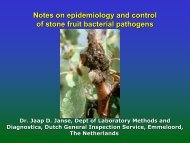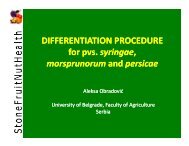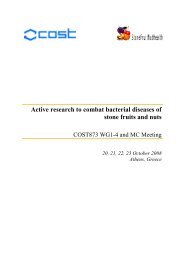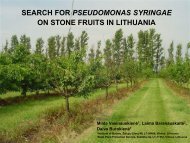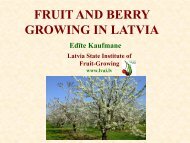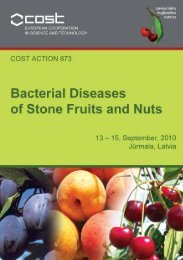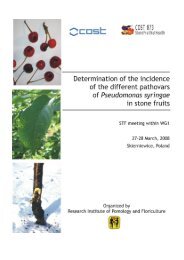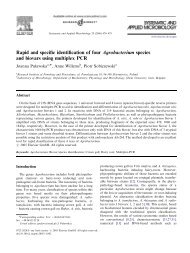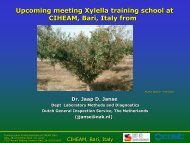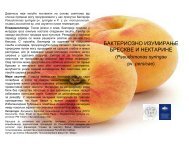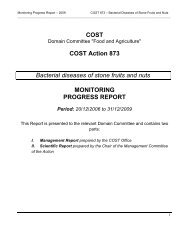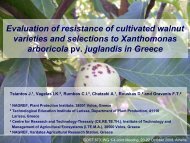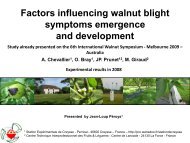Brown apical necrosis of walnut in Turkey - Cost 873
Brown apical necrosis of walnut in Turkey - Cost 873
Brown apical necrosis of walnut in Turkey - Cost 873
Create successful ePaper yourself
Turn your PDF publications into a flip-book with our unique Google optimized e-Paper software.
The two years <strong>of</strong> experience on<br />
etiology <strong>of</strong> <strong>apical</strong> <strong>necrosis</strong> on<br />
<strong>walnut</strong> <strong>in</strong> <strong>Turkey</strong><br />
Hatice ÖZAKTAN<br />
Senem AKAT Lalehan YOLAGELDİ<br />
Department <strong>of</strong> Plant protection, Faculty <strong>of</strong> Agriculture, University <strong>of</strong><br />
Ege, 35100 Bornova, İzmir / TURKEY<br />
hatice.ozaktan@ege.edu.tr
<strong>Brown</strong> <strong>apical</strong> <strong>necrosis</strong> <strong>of</strong> <strong>walnut</strong><br />
<strong>in</strong> <strong>Turkey</strong><br />
• SYMPTOMS: externally<br />
<strong>Brown</strong> to dark brown patches<br />
orig<strong>in</strong>ated at the stigmatic end <strong>of</strong><br />
nuts
<strong>Brown</strong> <strong>apical</strong> <strong>necrosis</strong> <strong>of</strong> <strong>walnut</strong><br />
<strong>in</strong> <strong>Turkey</strong><br />
• SYMPTOMS: <strong>in</strong>ternally<br />
• Symptoms on fruits rema<strong>in</strong><strong>in</strong>g the tree were a brown to dark-brown patch<br />
orig<strong>in</strong>at<strong>in</strong>g exclusively at the blossom end and a brown to blackish rot <strong>of</strong><br />
<strong>in</strong>ner tissues
<strong>Brown</strong> <strong>apical</strong> <strong>necrosis</strong> <strong>of</strong> <strong>walnut</strong> <strong>in</strong> <strong>Turkey</strong><br />
Rot <strong>of</strong> <strong>in</strong>ternal tissues is variable.<br />
Internal tissues become necrotic<br />
and blackish<br />
Fruits dropped to the soil<br />
Fruits rem<strong>in</strong>ed <strong>in</strong> the tree<br />
Necrosis <strong>of</strong> stigma and style can spread<br />
to <strong>in</strong>ternal tissues and reaches the kernel<br />
Fruits dropped to the soil
External and <strong>in</strong>ternal symptoms<br />
and severity <strong>of</strong> BAN disease<br />
sometimes do not correlate the<br />
<strong>in</strong>cidence <strong>of</strong> symptoms<br />
HOWARD ON THE SOIL<br />
VINA SYMPTOMATIC
AIM OF THIS RESEARCH<br />
• In 2009 and 2010, this research was<br />
carried out <strong>in</strong> a <strong>walnut</strong> orchard<br />
located <strong>in</strong> Marmara Region <strong>of</strong> <strong>Turkey</strong><br />
to substantiate the etiology <strong>of</strong> BAN.<br />
• symptom evolution and disease<br />
progress,<br />
• the microorganisms associated with<br />
brown <strong>apical</strong> necrozis (BAN),<br />
• Pathogenicity <strong>of</strong> isolated<br />
microorganisms, and<br />
• cultivar susceptibility have been<br />
monitored <strong>in</strong> a <strong>walnut</strong> orchard from<br />
May to August
Susceptibility <strong>of</strong> <strong>walnut</strong> cultivars to brown <strong>apical</strong> <strong>necrosis</strong> depend<strong>in</strong>g<br />
MARMARA SEA<br />
on causal agents<br />
Accord<strong>in</strong>g to results <strong>of</strong> 2009 year studies, we selected susceptible <strong>walnut</strong> cvs.<br />
to BAN for monitor<strong>in</strong>g the etiology <strong>of</strong> the disease <strong>in</strong> the orchard
1.Monitor<strong>in</strong>g the simptom development <strong>in</strong> survey area<br />
depend<strong>in</strong>g on the vegetation period<br />
SAMPLING DATES:<br />
• From May to August 2010 as<br />
twice <strong>in</strong> a month<br />
• 10 fruits per date and each<br />
cultivar <strong>in</strong> tree<br />
WALNUT CULTIVARS:<br />
• Hartley<br />
• Rendede<br />
• V<strong>in</strong>a<br />
• Howard<br />
• Bilecik (Local veriety)<br />
WALNUT ORCHARD:<br />
• The experimental orchard <strong>in</strong><br />
Yalova, Marmara Region <strong>of</strong> <strong>Turkey</strong>
V<strong>in</strong>a Symptomatic<br />
26 .05.2010<br />
Rendede Symptomatic
11.06.2010<br />
Hartley Symptomatic
25 June 2010<br />
Fruits dropped to the soil<br />
The disease started to cause a<br />
premature <strong>walnut</strong> fruit drop<br />
and a yield reduction at the<br />
mid <strong>of</strong> June 2010
12.07.2010
27.07.2010<br />
Severe fruit drops was<br />
observed on 27 June,2010
11.08.2010<br />
• Late <strong>in</strong>fections (August) <strong>of</strong> <strong>walnut</strong><br />
fruits after the shell harden<strong>in</strong>g satage<br />
localized only epicarp and mesocarp<br />
tissues<br />
• Fruit drops was more severe and<br />
<strong>apical</strong> <strong>necrosis</strong> extended to all <strong>in</strong>ternal<br />
tissues
Disease <strong>in</strong>cidence (%)<br />
80<br />
BAN <strong>in</strong>cidence <strong>in</strong> survey area depend<strong>in</strong>g on the sampl<strong>in</strong>g dates<br />
70<br />
60<br />
50<br />
40<br />
30<br />
20<br />
10<br />
0<br />
26.05.2010 11 June 26 June 12 July 29 July 11 August<br />
Hartley V<strong>in</strong>a Howard Rendede Bilecik<br />
Sampl<strong>in</strong>g dates
2. microorganisms associated with brown <strong>apical</strong> <strong>necrosis</strong><br />
EXOCARP<br />
ENDOCARP<br />
SEED<br />
SAMPLES FOR ISOLATION<br />
OF CAUSAL AGENTS:<br />
• 3 fruits per date and<br />
cultivar<br />
Symptomatic<br />
fruits <strong>in</strong> tree<br />
Symptomatic<br />
fruits dropped to<br />
the soils<br />
Non symptomatic<br />
fruits<br />
Samples <strong>of</strong> <strong>walnut</strong> fruits affected from BAN were taken to isolate the<br />
microorganisms associated to the disease on each tissue
Isolation Techniques :<br />
a<br />
b<br />
If the bacteria produced yellow colonies on<br />
YDC medium, we restriked them on TMM<br />
medium for observation prespitation zone on<br />
TMM medium. Identification <strong>of</strong><br />
microorganism was based on morphological<br />
traits and growth on the media and<br />
pathogenicity on tomato leaflets and nuts.<br />
Piece <strong>of</strong> tissues were break <strong>in</strong>to pieces with bistoury and we cultured on YDC,TMM<br />
medium for bacterial development.(a)<br />
Piece <strong>of</strong> tissues were cultured on PDA with streptomic<strong>in</strong> for fungal microorganisms.(b)
Isolation frquency (%)<br />
the isolated microorganisms associated with brown<br />
<strong>apical</strong> necrozis from May to August 2010<br />
100<br />
90<br />
80<br />
70<br />
60<br />
50<br />
40<br />
30<br />
20<br />
10<br />
0<br />
26.May 11 June 26 June 12 July 29 July<br />
Xaj Alternaria Fusarium
Isolated microorganisms<br />
90<br />
80<br />
70<br />
60<br />
50<br />
40<br />
30<br />
20<br />
10<br />
0<br />
Isolated microorganisms depend<strong>in</strong>g on the different sampl<strong>in</strong>g dates<br />
May June July<br />
Months<br />
X.a.j Alternaria sp. Fusarium sp.
Microorganims isolated from simptomless<br />
<strong>walnut</strong> fruits<br />
• X.a.pv juglandis isolated<br />
from simptomless fruits <strong>in</strong><br />
2009 and 2010 years at the<br />
rate <strong>of</strong> 5% and 14%,<br />
respectively.<br />
cv. V<strong>in</strong>a simptomless<br />
cv.V<strong>in</strong>a simptomless<br />
cv.Rendede simptomless
Microorganims isolated from <strong>walnut</strong> fruits dropped on<br />
the soil<br />
Cv .Rendede on the soil<br />
3%<br />
2009<br />
20%<br />
12%<br />
32%<br />
16%<br />
13%<br />
2010<br />
Xaj Fusarium Alternaria<br />
Xaj Fusarium Alternaria
Pathogenicity tests on detached <strong>walnut</strong> fruits<br />
<strong>of</strong> isolated microorganisms from BAN simptoms<br />
• Inoculations on detached immature fruits (GF+30, cv. Hartley)<br />
• Walnut fruits were <strong>in</strong>oculated by plac<strong>in</strong>g a mycelial disc (2-3mm) on the<br />
stigmatic end for fungal pathogens.
Pathogenicity tests <strong>of</strong> isolated microorganisms from<br />
BAN simptoms on <strong>walnut</strong> fruits<br />
• Bacterial suspensions were <strong>in</strong>filtrated <strong>in</strong>to stigmatic end <strong>of</strong> fruits as<br />
30µl per each nut<br />
• The <strong>in</strong>cubation lasted 14 days at 24 0 C, RH over 90%.<br />
• Microorganisms 5 replicates, 2 fruit/replicate<br />
• external and <strong>in</strong>ternal <strong>in</strong>fection was evaluated by 0-4 scale
Pathogenicity tests <strong>of</strong> isolated microorganisms from<br />
BAN simptoms on <strong>walnut</strong> fruits<br />
Tested<br />
Isolates<br />
Disease severity <strong>of</strong> tested stra<strong>in</strong>s on <strong>walnut</strong> fruit tissue<br />
%0 0-5% 6-25% 26-50% 51-88%<br />
X. arboricola<br />
pv. Juglandis<br />
(33 stra<strong>in</strong>s)<br />
Alternaria<br />
sp. (7 stra<strong>in</strong>s)<br />
Fusarium sp.<br />
(9 stra<strong>in</strong>s)<br />
Other Fungi<br />
(11 stra<strong>in</strong>s)<br />
6 1 6 12 8<br />
6 1 - - -<br />
4 - 5<br />
11 - - - -<br />
* BAN symptoms on <strong>in</strong>oculation po<strong>in</strong>ts <strong>of</strong> fruits were evaluated by 0-4 scale
Xaj <strong>in</strong>oculation on immature nuts<br />
CONTROL (-)
Pathogenicity test<br />
results <strong>of</strong> Fungal stra<strong>in</strong>s<br />
on immature nuts<br />
Fusarium spp.<br />
Alternaria spp<br />
Fungal organisms isolated from BAN symptoms were <strong>in</strong>oculated on the nuts,<br />
but, they couldn’t produce typical BAN symptoms
<strong>Brown</strong> Apical Necrosis <strong>in</strong>cidence (%)<br />
<strong>Brown</strong> Apical Necrosis Incidence<br />
(%)<br />
Susceptibility <strong>of</strong> <strong>walnut</strong> cultivars to brown <strong>apical</strong><br />
<strong>necrosis</strong> depend<strong>in</strong>g on causal agents<br />
60<br />
50<br />
2009<br />
40<br />
30<br />
20<br />
10<br />
0<br />
Howard Rendede Hartley V<strong>in</strong>a Bilecik<br />
Walnut Cultivars<br />
X.a.j A.alternata Fusarium<br />
2010<br />
90<br />
80<br />
70<br />
60<br />
50<br />
40<br />
30<br />
20<br />
10<br />
0<br />
Hartley V<strong>in</strong>a Howard Rendede Bilecik<br />
Walnut cultivars<br />
X.a.j<br />
Alternaria sp.<br />
Fusarium sp.
IN CONCLUSION:<br />
• Infections could be observed <strong>in</strong> <strong>walnut</strong> fruits from fruit set<br />
to harvest, but they are more <strong>in</strong>tense at early fruit<br />
development stages, when cause major fruit drop.<br />
• Initial <strong>in</strong>fections were observed <strong>in</strong> exocarp tissues at the<br />
end <strong>of</strong> May <strong>in</strong> <strong>Turkey</strong>.<br />
• Symptoms were more visible <strong>in</strong> the first half <strong>of</strong> June than<br />
May, and the <strong>in</strong>cidence <strong>of</strong> BAN <strong>in</strong>creased dur<strong>in</strong>g the<br />
grow<strong>in</strong>g season, with full expression <strong>in</strong> the first and<br />
second half <strong>of</strong> July<br />
• Infections <strong>in</strong> young fruits observed <strong>in</strong> July affected<br />
epicarp tissues and reached kernel whereas late<br />
<strong>in</strong>fections (August) <strong>of</strong> <strong>walnut</strong> fruit localized only epicarp<br />
tissues.<br />
• The extent <strong>of</strong> external and <strong>in</strong>ternal lesions <strong>of</strong> the style<br />
were not correlated on symptomatic fruit.<br />
• Premature fruit drops on the soil observed from<br />
25.06.2010 to 11.08.2010
In Conclusion<br />
• All fruits <strong>in</strong>oculated with X. arboricola pv. juglandis produced<br />
typical external and <strong>in</strong>ternal symptoms <strong>of</strong> BAN, similar to<br />
those observed with natural <strong>in</strong>fections with<strong>in</strong> fifteen days after<br />
<strong>in</strong>oculation. Fusarium spp. caused only limited external<br />
necroses <strong>of</strong> the style on the <strong>in</strong>oculated fruit. Alternaria spp<br />
couldn’t produce typical symptoms after artificial <strong>in</strong>oculation<br />
on detached nuts.<br />
• Fusarium spp. and Alternaria spp. also seem to be <strong>in</strong>volved <strong>in</strong><br />
<strong>apical</strong> <strong>necrosis</strong> <strong>of</strong> <strong>walnut</strong> caus<strong>in</strong>g secondary <strong>in</strong>fections or<br />
grow<strong>in</strong>g as saprophyte on bacterial <strong>in</strong>fected tissues, enhanc<strong>in</strong>g<br />
the disease symptoms and severity.<br />
• Most commercially cultivars were susceptible to <strong>apical</strong><br />
<strong>necrosis</strong>. “Hartley”, “Bilecik”, “V<strong>in</strong>a”, “Rendede”, “Howard”,<br />
and “Serr” were highly susceptible to <strong>apical</strong> <strong>necrosis</strong>.<br />
• Accord<strong>in</strong>g to these results, Xaj can be considered as the ma<strong>in</strong><br />
causal organism <strong>of</strong> <strong>apical</strong> <strong>necrosis</strong> <strong>of</strong> <strong>walnut</strong> whereas Fusarium<br />
spp. can occasionally be <strong>in</strong>volved <strong>in</strong> the disease, <strong>in</strong>teract<strong>in</strong>g<br />
with bacterial <strong>in</strong>fections. The presence <strong>of</strong> Alternaria spp. on<br />
necrotic tissues may be related more to the opportunistic<br />
colonization <strong>of</strong> dead tissues previously <strong>in</strong>fected by the<br />
bacteria.
THANK YOU FOR YOUR ATTENTION
BAN<br />
BACTERIAL<br />
BLIGHT OF<br />
WALNUT<br />
CAUSED BY<br />
XAJ




